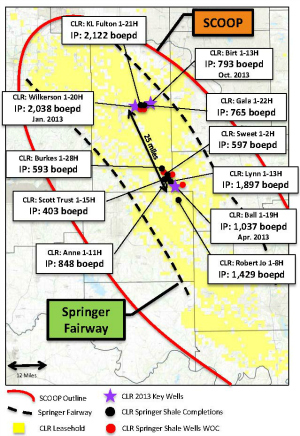Recent announcements have positioned the Springer Shale as a potentially prolific producer at 12,500 ft depth, with Continental Resource’s initial tests producing more than 2,000 barrels per day.The Springer, which is a Mississippian-Pennsylvanian boundary zone formation has been an important oil and gas producer in both southern Oklahoma and in the Anadarko Basin.
 Recent announcements have positioned the Springer Shale as a potentially prolific producer at 12,500 ft depth, with Continental Resource's initial tests producing more than 2,000 barrels per day.
Recent announcements have positioned the Springer Shale as a potentially prolific producer at 12,500 ft depth, with Continental Resource's initial tests producing more than 2,000 barrels per day.
The Springer, which is a Mississippian-Pennsylvanian boundary zone formation has been an important oil and gas producer in both southern Oklahoma and in the Anadarko Basin.
Now, however, the shale is being targeted, which causes one to ask many questions about the source of the oil, the migration, and also the potential accessible porosity and natural fracture networks, within an often highly complex structural regime.
A paper at the AAPG Granite Wash and Pennsylvanian Sand Forum (Sept 25) takes a look at published work that explains the depositional environment of the Springer, along with pivotal geochemical work that suggests how the Springer is self-sourcing and that the oil that is trapped in the Springer did not have to migrate from the more well-known sourcerock, the Woodford.
If, in fact, the Woodford could be another source for the oil in the Springer shale(s), as USGS publications suggest,then what does this indicate about natural fracture networks, and also the petrophysical attributes of the Springershale, and accessible porosity.
The presentation also reviews the potential for new techniques in horizontal drilling, stacked pays, and identifying sweet spots, and optimizing production from sweet spots, while avoiding or minimizing stranded pay.